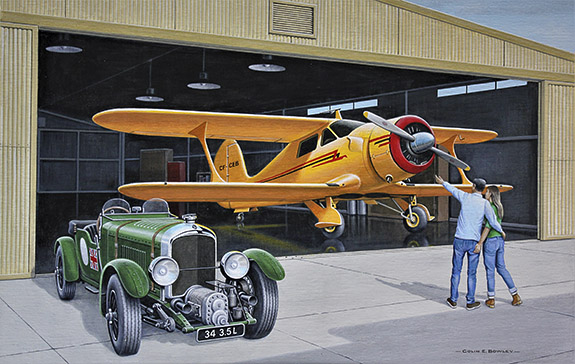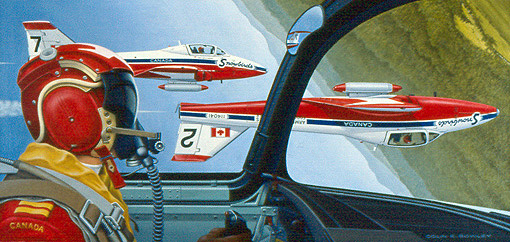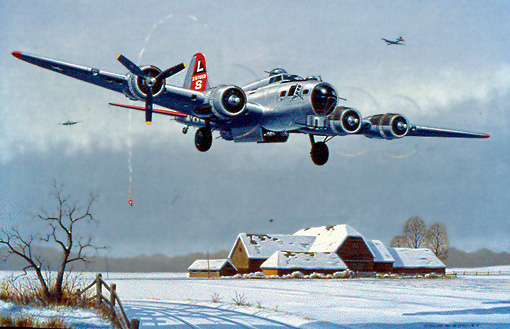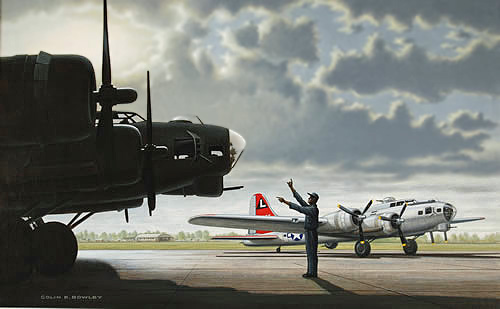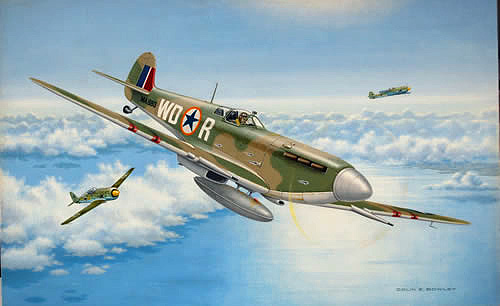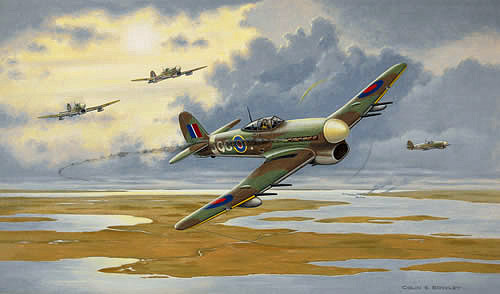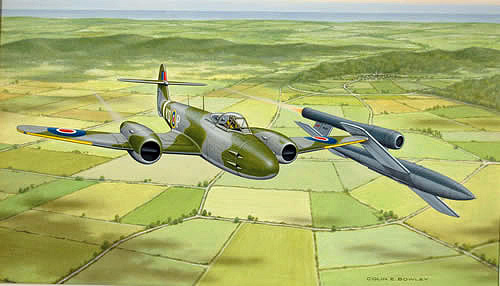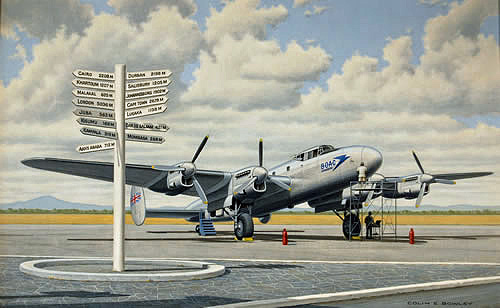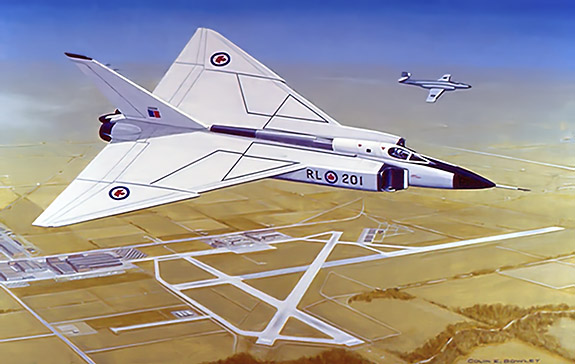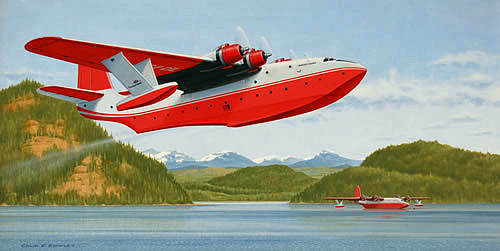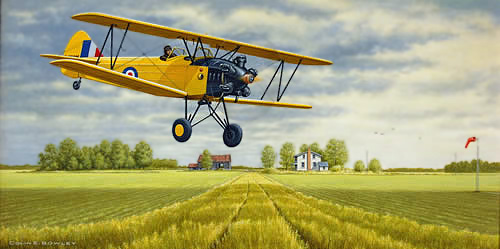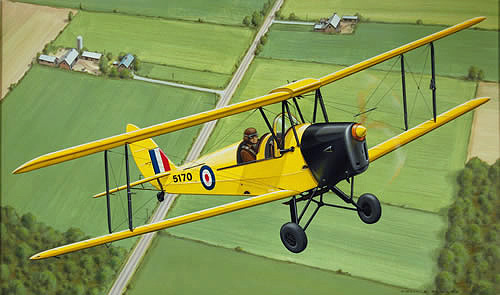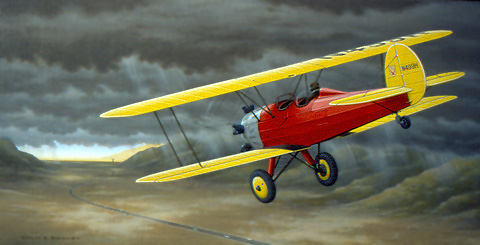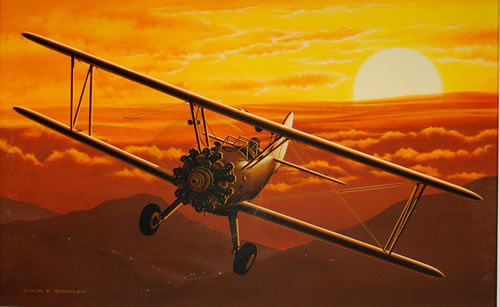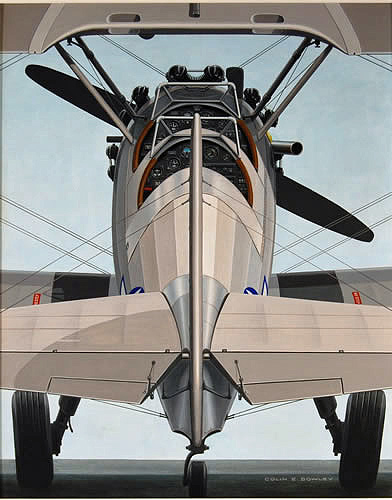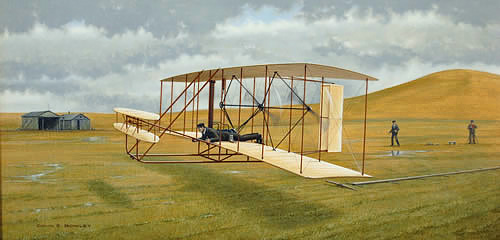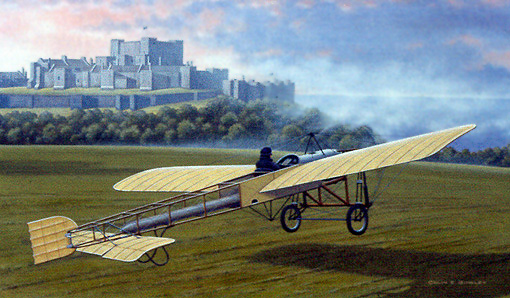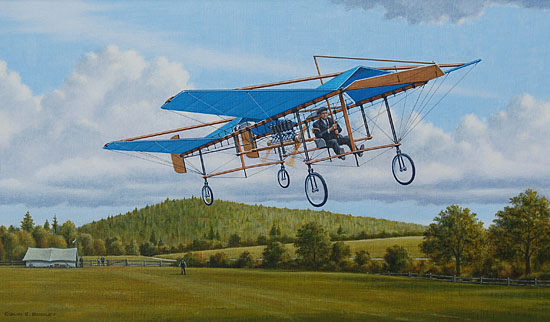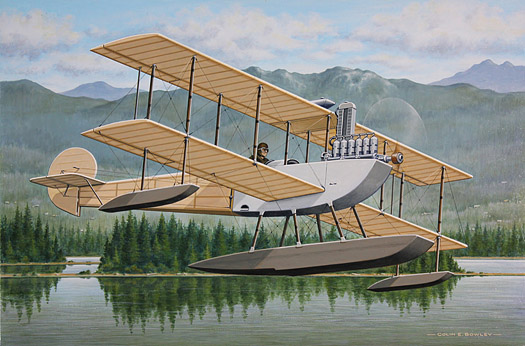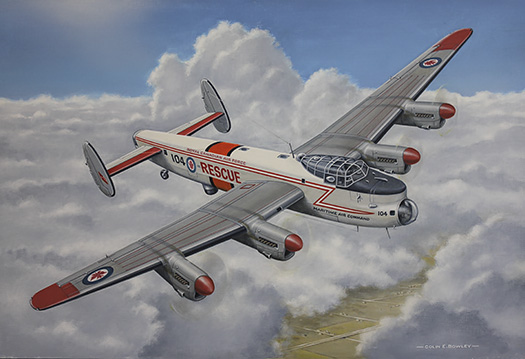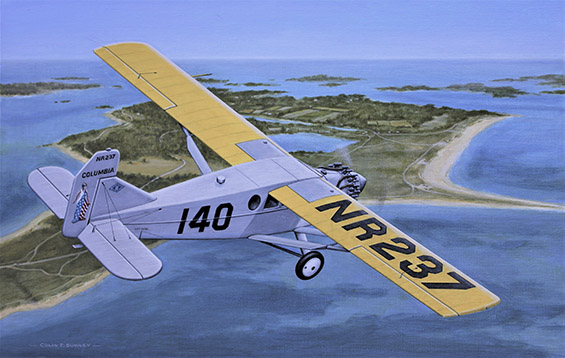

|

|

|
Colin E. Bowley
Colin lives on Vancouver Island, B.C where he devotes much of his time to his painting, both landscapes and aviation subjects. The two As (Aviation and Art) have always been a big part of his life. As a young man he enlisted in the Royal Air Force and served for six years in Africa, the Middle East and England. On return to civilian life he worked as a Commercial Artist in various studios in Toronto and also as a Technical Artist at the Avro Aircraft Company during its final dramatic days. He started his own Commercial Art business in 1973 and moved to B.C in 1985. During these years he continued to fly and has owned several aircraft and logged many hours during this time. He is now retired and paints full-time. He has received various awards and has work in private, public and corporate collections.
“..... and this is my classic Staggerwing“
by Colin E. BowleyIn 1931 aircraft executive WALTER BEECH and aircraft designer TED WELLS joined forces to produce the BEECHCRAFT MODEL 17 a large, fast and powerful cabin biplane, aimed directly at the business executive.
The next year major modifications were made and the aircraft went in to production as the BEECHCRAFT MODEL D17. Because of its unusual negative wing configuration, where the upper wing is staggered behind the lower wing, it naturally very quickly become known as the STAGGERWING.
785 Model D17’s were produced from 1932 to 1949 and recent records show that about 200 of this classic aircraft are still flying today.16 x 24 inches, Acrylic on Canvas
Copyright Colin E. Bowley 2022
The Snowbirds
by Colin E. BowleyThe Canadair CT-114 Tutor, which served for over 30 years as a jet trainer in the Canadian military, has now been officially retired. Seventeen Tutors, modified and dressed up for the Snowbirds aerial demonstration team, will remain in service until 2006 when a decision will be made regarding their replacement.
12 x 24 inches, Acrylic
Nearly Home
by Colin E. BowleyWinter 1944. Somewhere in Southeast England a B-17G Flying Fortress finally makes it back to base. On short final, with on-board casualties, no flaps, one engine dead with an unfeathered propeller, the pilot has his hands full...but at least they are nearly home.
12 x 24 inches, Acrylic
Start Three
by Colin E. Bowley1944 - Early morning on an 8th Air Force base somewhere in the south-east of England a crew chief with the 361st. Bomb Group signals to the pilot of a B-17G to start his number three engine. The first production B-17 was delivered in June 1930 and was officially named the Flying Fortress. when production finally stopped in April 1945 with the B-17G model Boeing had built 4,035, Douglas 2395 and Vega (Lockheed) 2250 for a total of 12,731.
19 x 24 inches Acrylic
'Seconds Later My Engine Exploded'
by Colin E. BowleyR.A 'Bob' Hoover is Shot Down
9 February 1944Flying from their new base in Calvi, Corsica, the four Spitfires of Bob Hoover's formation had attacked the enemy along the coast of France and Italy between Cannes and Genoa.
While returning to base and just off the coast near Nice they were intercepted by four Focke-Wulf 190s.
Bob was unable to jettison his long-range fuel tank due to a mechanical malfunction so the speed and performance of his Mk.V Spitfire was seriously degraded. He was however able to get some hits on the FW-190's before he was shot down at about 1500 hours.
Bob was injured but able to get out of his aircraft and parachute into the sea, where he was picked up a few hours later by the Germans and so became a Prisoner-of-War.
15 x 24 inches, Acrylic
Jack Earle Heads for Home
by Colin E. BowleyOn the 3rd February 1944 a flight of four Typhoons from No.3 Squadron, based at Swanton Morley in Norfolk, England, made a number of low-level attacks on enemy shipping around the Dutch Frisian Islands.
The four pilots of Green Flight that day were, Squadron Leader Dredge, Flying Officer Tidy, Warrant Officer Earle and Flight Sergeant Slade-Betts.
During one of the attacks W/O 'Jack' Earle's aircraft JR 188 was damaged and the four aircraft all turned for home-base. Just twenty miles from the coast Earle's aircraft finally quit and it was seen to crash into the North Sea where it sank almost immediately. The body of the pilot was never recovered.
R95852 W/O1 John Clifford Morris Earle who was from Cornwall, Ontario, Canada, was at age 22, listed as Killed in Action. He has no known grave, but his name is inscribed on the Runnymeade Memorial at Englefield Green, Egham, Surrey, England.
14 x 24 inches, Acrylic
A Gloster Meteor Intercepts a V-1 Flying Bomb
by Colin E. Bowley1944- A Gloster Meteor of 616 Squadron operating from Manston in Kent intercepts a German V-1 Flying Bomb bound for London.
Shooting at a V-1 proved to be extremely dangerous. To be within range to shoot also meant being close enough to be damaged by the huge explosion and deadly flying shrapnel.
Some pilots were able to fly alongside and gently tip the wing of the V-1 to send it out of control and into the empty fields below.
23 x 15 inches, Acrylic
Avro 691 Lancastrian, Nairobi, East Africa, 1947
by Colin E. Bowley
Shortly after World War II was over some of the major airlines were desparately looking around for suitable aircraft so that they could resume operations.
To help solve this immediate need the Avro Aircraft Company came up with a short term solution. It was the Avro Lancastrian.
It was a conversion of the very successful Lancaster bomber. The nose and tail turrets were removed and replaced with streamlined fairings and the main cabin was converted for seating for passengers.
The Lancastrian helped a number of airlines to get back on their feet. It served with B.O.A.C, Quantas and Trans Canada airlines to name a few, but soon was replaced as more modern and suitable aircraft came along.
15 x 24 inches, Acrylic
First Flight of the CF-105 Avro Arrow
March 25 1958
by Colin E. BowleyCanada's first supersonic aircraft was considered at the time to be years ahead of any other aircraft of its type in production. Then, on "Black Friday" 20 February, 1959, an unbelievable political decision was made to scrap the entire Arrow project, effective immediately. In an instant, the result of years of dedicated work by thousands of skilled people was wiped out.
15 x 23 inches, Acrylic
The Red Giants of Sproat Lake
by Colin E. BowleyFive (JRM-1) Martin Mars Flying Boats were built and served with the US Navy in WWII.
One of the flying boats the "Marshall Mars" was destroyed while in service with the USN, and the remaining four were auctioned off in 1959.
Forest Industries Flying Tankers (FIFT) purchased the lot for $100,000 together with thirty-five "zero-time" engines for $300 a piece.
They were converted to water-bomber status in Victoria,BC. In 1961 one of them, "Marianna Mars" was lost when it hit some trees and crashed while another, "Carolina Mars" was so so badly damaged during typhoon Frieda in 1962 that it had to be scapped.
"Hawaii Mars" and "Phillipne Mars" are still busy today, flying out of Sproat Lake on Vancouver Island to wherever they are needed to fight forest fires.
12 x 24 inches, Acrylic
The Fleet 16B Finch - by Colin E. Bowley
Between 1939 and 1941 the primary pilot trainers in the Canadian Air Force were the Fleet Finch and the Tiger Moth.
A total of 606 Fleet Finch aircraft were built for the RCAF and were powered by the 125 hp Kinner five cylinder air-cooled radial engine.
The aircraft which was similar to the Fleet 10 entered service with tandem open cockpits but was soon modified by the addition of a sliding canopy to help cope with the severe Canadian winters.
12 x 24 inches, Acrylic
The deHavilland DH82A Tiger Moth
by Colin E. BowleyFrom the 1930s to well into the 1940s the Tiger Moth was the elementary trainer used by the RAF and RCAF.
Although it was cold and draughty and the early models had no brakes it did have a strong and forgiving landing gear and was a pure delight to fly.
Derived from the DH-60 Moth the first DH-82 Tiger Moth was flown for the first time on the 26th October, 1931. It was powered by a 120 hp Gipsy engine and in 1937 it received the larger 130 hp Gipsy Major engine and was re designated the DH-82A Tiger Moth.
When it finally went out of production over 800 had been built.
16 x 27 inches, Acrylic
Sneaking Through at Banning
by Colin E. BowleyThe adventure began in North Carolina where Richard Bach (the author of Jonathan Livingston Seagull) traded his modern plane for an old open cockpit biplane and flew it across the country back to his California home. Here he is almost home in his 1929 Detroit-Ryan Speedster, trying to beat the weather. "Banning fades slowly into the rain behind us....We are one mile from the opening between the clouds and the ground. If it stays open for another minute and a half we'll be through" - Richard Bach - 'Biplane'
12 x 24 inches, Acrylic
At the End of the Day
by Colin E. Bowley"Flying home in the gold of the setting sun in that magical time when the day is done. With burnished wings we still catch the light while it darkens below as we end our flight.
Up here all alone we can loop and roll and do other things that nourish the soul. When we finally land and sit for a while people may wonder why we wear such a smile.
To simply explain is a difficult thing how can you say what makes your heart sing. You may talk about joy and the sheer delight but that is only a part of the wonder of flight."The Boeing (A75N1) PT-17 Stearman
15 x 24 inches, Acrylic
The Boeing (A75N1) PT-17 Stearman
by Colin E. BowleyThe Stearman is one of those airplanes that seems to evoke nostalgic thoughts for all those who have even had a passing acquaintance with her. For those pilots who have been lucky enough to fly this fine aircraft most of the memories are fond ones.
The model 75 primary trainer first appeared in 1934 and went into production for the US Army as the PT13 and had a 215hp Lycoming R680-5 radial engine. Later the same airframe, now with a 225hp Jacobs R755-7 became the famous A75N1(PT18) sometimes called the "Yellow Peril" in recognition of the yellow training paint scheme for air force flight trainers. The version supplied to the RCAF was designated the PT17 Kaydet.20 x 16 inches, Acrylic
Twelve Seconds and 120 feet
by Colin E. Bowley17 December 1903 - The Wright brothers "Flyer-1" makes the first powered, sustained and controlled flight in history, with Orville Wright as pilot.
The flight only lasted 12 seconds, but it was the first time that a machine carrying a man had raised itself into the air by its own power, had sailed forward without any reduction in speed, and had finally landed at a point as high as that from which it had started.
The Wright brothers made three more flights that day, each covering a greater distance. The final flight of the day covered 852 feet and stayed aloft for 59 seconds.
10 x 16 inches, Acrylic
Bound For France
by Colin E. BowleyApril 16, 1912. As the early morning fog clears, Harriet Quimby takes off from a field near Dover Castle on her attempt to be the first woman to fly across the English Channel. She succeeded and landed on a sandy beach at Hardelot, France, just south of Calais. Quimby was the first licensed woman pilot in the U.S.A., but her career was tragically cut short when she was killed during a sight-seeing flight at the Harvard-Boston Aviation Exhibition.
16 x 24 inches, Acrylic
Gibson's Triumph, 1910
by Colin E. BowleyThe Gibson Twinplane was the first airplane in Canada that was designed by a Canadian, built by a Canadian, and flown by a Canadian. All of the other aircraft in Canada up to that time, including the Silver Dart, were built in the USA.
William Wallace Gibson made many attempts to get his unusual flying machine airborne and finally he was successful. On the 24th September 1910 at Dean's Farm near Mount Tolmie in Victoria, British Columbia, Gibson flew his Twinplane for just over 200 feet and so became the first Canadian to fly a Canadian-built aircraft. Encouraged by this success, he continued with his experiments and made many modifications to his original design.
The aircraft made its final flight in Calgary, Alberta where, on 11 August 1911, it crashed while landing on some unsuitable ground and was destroyed. Gibson announced that he intended to rebuild the aircraft and continue with his experiments, but by then he was running out of money and shortly after decided he would give up aviation altogether and return to his other business affairs.12 x 22 inches, Acrylic
The 1917 Hoffar H-1
by Colin E. BowleyOne of the earliest aviation achievements in British Columbia involved the boat-building brothers James and Henry Hoffar, who were born in Vancouver in the late 1800's.
In 1914 they became seriously interested in flying. In 1912 the British magazine 'Flight' had published a series of articles about the Avro Biplane and, using these articles as a guide, the brothers decided they would build their own seaplane.
The aircraft was designated the Hoffar H-1. It was constructed of Ash and Spruce, fabric covered, and braced with piano wire. Power was provided by a Roberts 6X boat engine, a six cylinder, water-cooled, two cycle engine, rated at 75 horsepower.
By the summer of 1917 the H-1 could often be seen taxiing or flying around the Burrard Inlet and Coal Harbour. On one occasion it was reported to have reached an altitude of 2000 feet, and it also claimed to be the first airplane to fly over downtown Vancouver.
The life of the H-1 unfortunately was to be a very short one, and by the end of the year it was deteriorating so badly that after saving the engine and the propeller, the rest of the aircraft was scrapped and the remains were 'buried at sea'.16 x 24 inches, Acrylic
RCAF Mk.10 Avro Lancaster FM 104
by Colin E. BowleySearch and Rescue 1965
FM 104 is a Mk.10 Avro Lancaster bomber. It was built in Toronto by the Victory Aircraft Company in 1944.
In 1945 it was flown to England and stored at a Maintenance Depot until it could be assigned to an active service squadron. This never happened and later that year it was flown back to Canada without ever being involved in any combat duties.
The following years were spent with the RCAF on Search and Rescue duties on the east coast and in 1966 it was finally retired from service. Shortly after retirement it was put on display in a Toronto park mounted on a concrete plinth. There it sat for over 30 years, unprotected and totally exposed to the unforgiving weather.
In 1999 it was rescued by the Canadian Aerospace Museum and put into storage. Next, it was taken over by the City of Toronto, but the city, not knowing what to do with it, decided to get rid of it.
In 2018 FM 104 finally found a new home at the British Columbia Aviation Museum in Sidney B.C. where a full restoration of the aircraft is now in progress.16 x 24 inches, Acrylic
Canada's Lindbergh
by Colin E. BowleyThe first Canadian to fly the Atlantic was James Erroll Boyd of Toronto.
He took off from Harbour Grace, Newfoundland in a Bellanca WB-2 on the 9 October 1930 bound for England. 24 hours 10 minutes later fuel problems forced him to first land on a beach at Tresco in the Scilly Isles. The next day he flew on to his intended destination, Croydon Airport, south of London.14 x 22 inches, Acrylic on canvas


